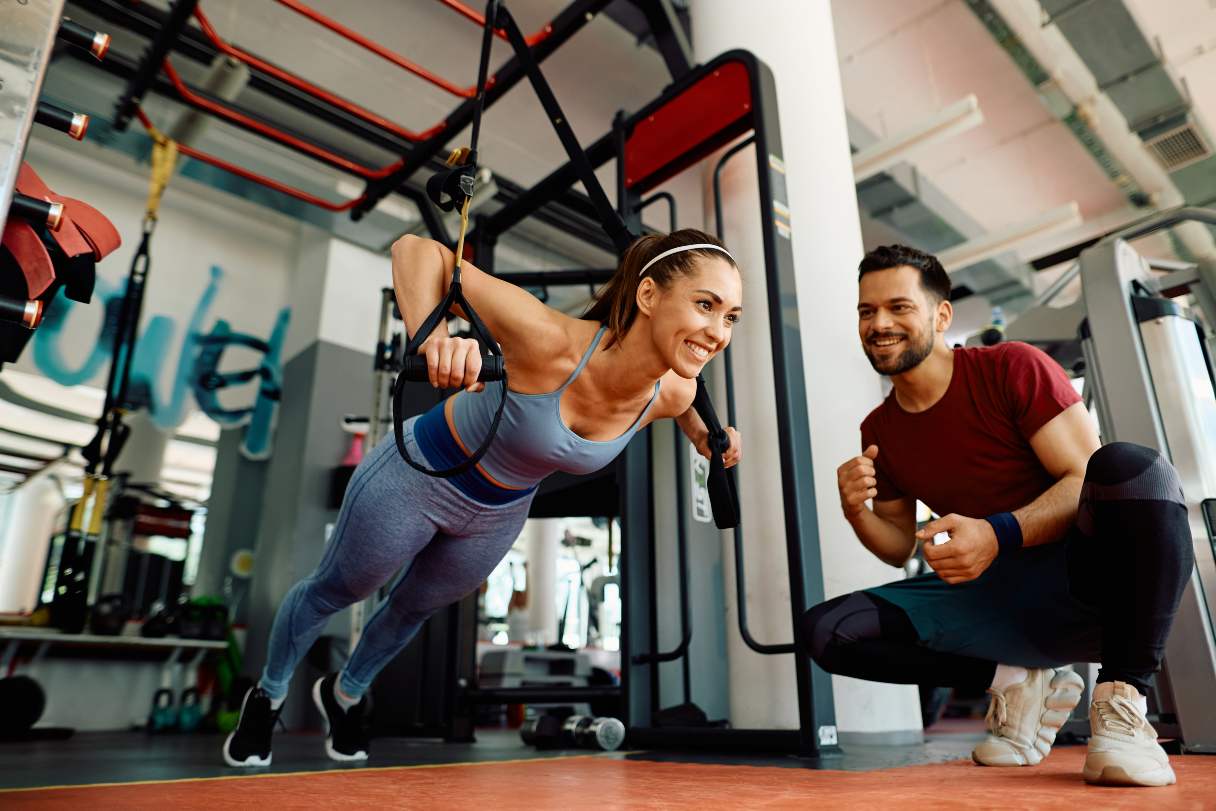It is natural for breasts to lose their shape over time, but many women feel self-conscious about sagging breasts and would like to do something to bring back their perkiness. And the appeal of round, lifted breasts goes beyond aesthetics for some — it also helps with comfort, confidence and posture.
Through regular and targeted exercises, it is possible to give a lifted appearance to breasts. Working out can help strengthen the muscles around the chest area, contributing to better lift and support.
It is important to remember that breasts do not contain any muscles. They are surrounded by muscle, but they are made of mostly glandular and fatty tissue. Exercise will not change the breasts themselves — instead, it will tone the muscles around them.
Those who want a more drastic change in their breasts' appearance may want to consider exploring surgical breast augmentation options. They can also invest in the right supportive underwear.
Below, we'll dive into some targeted exercises that can help make breasts look firmer and fuller. It is best to make sure you talk with your doctor before doing any of the following exercises.
Read Related Articles
Breast Lift vs. Breast Augmentation: What's the Difference?
What Is a Vampire Breast Lift? Procedure and Cost Guide
1. Chest Press
The chest press focuses on the chest and pectoral muscles and engages the arms, shoulders and core. It is a great exercise to help firm your breasts.1
How to do a chest press
Follow these steps to do a chest press:1
-
Start with 10- to 15-pound dumbbells (you can go heavier as you progress).
-
Lie down with your back flat. You can use an exercise mat, bench or stability ball. The stability ball can help engage your core and improve flexibility.
-
Ensure your knees are bent and your feet are flat on the floor.
-
Hold a dumbbell in each hand and raise your arms above your chest until the dumbbells slightly touch. Your palms should be facing your feet.
-
Slowly bring your arms down by bending your elbows. Continue lowering until your arms reach a 90-degree angle.
2. Chest Fly
The chest fly is similar to the chest press. It engages the chest, shoulder and arm muscles, improving flexibility and coordination. Chest flys are good for stretching the chest muscles, which can help lift your breasts.2
Like with the chest press, you will need dumbbells. You can start with 10- to 15-pound weights or whatever feels comfortable.
How to do a chest fly
Follow these steps to do a chest fly:2
-
Lie on your back, either on a mat on the ground or a bench. Keep your knees bent and your feet flat on the floor.
-
Hold a dumbbell in each hand and raise your arms above your chest, palms facing each other and elbows slightly bent. It’s important not to lock your elbows.
-
Slowly lower your arms in an opening motion (making the shape of an arc) until your elbows align with your chest.
-
Push your arms back up in a closing motion until you return to the starting position.
3. Lateral Raises
While the lateral raise largely targets shoulder muscles, this exercise indirectly strengthens your pectoralis muscles by forcing them to stabilize the active muscles.3 Therefore, working these muscles may also increase the firmness of the muscles below your breasts.
How to do a lateral raise
Follow these steps to do a lateral raise:3
-
Start by holding an appropriately sized weight in each hand.
-
Raise your arms up so that you feel your scapula muscles engage (the wing-like muscles of your back).
-
Keep lifting until your arms reach shoulder height.
-
In a controlled manner, lower back down. Then repeat.
4. Push-Ups
The push-up is a classic exercise that improves upper-body strength and core stability. It also does not require any special equipment. Push-ups can engage your chest and pecs, enhancing your breasts' appearance.1
How to do a push-up
Follow these steps to do a push-up:1
-
Start with a plank position, placing your hands slightly wider than your shoulders. Your body should form a straight line from your head down to your feet.
-
If you cannot do a plank position, you can also position yourself on all fours, with your hands and knees to the ground. Your body should form a straight line from your head to your knees, lifting your feet slightly off the ground.
-
Slowly lower your body to the ground by bending your elbows.
-
Continue lowering yourself until your chest touches the floor, with both arms at a 45-degree angle.
-
Slowly push yourself back up to the original position.
5. Wall Push-Ups
Wall push-ups are a standing variation of regular push-ups. They engage the chest, shoulders and arms.4
How to do a wall push-up
Follow these steps to do a wall push-up:4
-
Stand facing a wall, about 2 feet away from it.
-
Place your palms on the wall.
-
Both your hands and feet should be shoulder-width apart.
-
Slowly bend your elbows until your chest touches the wall. It is just like a push-up but against the wall instead of the floor.
-
Slowly push yourself back to the original position.
6. Dumbbell Pullovers
This exercise engages your core and helps with flexibility. Dumbbell pullovers are great for the shoulders, chest and back. When done regularly, they can help tone and increase chest muscles.1
How to do a dumbbell pullover
Follow these steps to do a dumbbell pullover:1
-
You will need one heavy dumbbell or two slightly lighter dumbbells.
-
Sit at the end of a bench or on a stability ball. Lie on your back and keep your feet touching the floor.
-
Hold one dumbbell with two hands, or one in each hand, but held close together. Raise your dumbbells above your chest with your arms outstretched.
-
With your arms still outstretched, slowly lower the dumbbell or dumbbells in an arc until it is behind your head. You should feel your chest stretch.
-
After a short pause, lift your arms back into the original position.
7. Arm Circles
Arm circles are a simple exercise that engages your shoulders, chest and upper back.5
How to do arm circles
Follow these steps to do arm circles:5
-
Stand with your legs hip-width apart.
-
Holding a light dumbbell in each hand, raise your arms to the sides.
-
While holding this T position, rotate your arms clockwise simultaneously. (You can also move counterclockwise). Repeat as desired.
8. Plank With Shoulder Taps
A plank with shoulder taps is a variation of the classic plank. This exercise can work to improve the shoulders, chest and core.
How to do a plank with shoulder taps
Follow these steps to do a plank with shoulder taps:6
-
Start with a plank position. You should position your hands directly under your shoulder, with your whole body aligned. Your body should form a straight line from your head to your feet.
-
Lift one hand and tap it on the opposite shoulder. Then, place your hand back into its original position.
-
Repeat the same step with your opposite hand.
9. Traveling Plank
A more advanced variation of the classic plank, the traveling plank requires strength and coordination.7
How to do a traveling plank
Follow these steps to do a traveling plank:7
-
Start in a high plank position, with your hands directly under your shoulders, your head and neck neutral and your back straight.
-
With your core tight, resisting arching your back, lift your right hand and foot and move laterally — that is, to the side. You can choose to go right or left first.
-
After a pause, repeat the step five more times.
-
Repeat the exercise in the opposite direction.
10. Plank Rotation
A variation on the plank is one known as a plank rotation, or a side plank with rotational reach, which conveys many of the same benefits as a traditional plank.8
How to do a plank rotation
Follow these steps to do a plank rotation:8
-
Adopt the position of a side plank (can be done on either forearm or full arm). Your elbow should be beneath your shoulder.
-
Lift your hips off the ground and try to make your body into a straight line.
-
Engage your glutes as you reach your top hand to the ceiling.
-
Then, reach your top hand down and under your armpit, as though you’re trying to reach to the wall behind you. Your chest should rotate toward the ground. Keep your hips up.
-
Rotate back up, reaching toward the ceiling again.
-
Repeat on the other side.
11. Pec Deck Machine
The pec deck machine can improve chest muscle mass by isolating the pectoralis muscles.9 For those looking to enhance the appearance of their breasts, this piece of equipment can help.
How to use a pec deck machine
Follow these steps to use a pec deck machine:9
-
Choose the weight.
-
Sit on the platform with your back against it and your feet on the ground.
-
Adjust the machine so the bottom arm pads line up with your chest.
-
Take one handle with each hand and rest your elbows on the resting pad. If the machine does not have one, position your arms so your elbows bend at a 90-degree angle.
-
While holding the handles, pull your arms together until the handles are in front of your chest.
-
Hold briefly before releasing your arms back to the original position.
12. Superman
Poor posture can make sagging breasts more pronounced. Thus, doing exercises that improve back and shoulder strength is important. The superman exercise helps correct bad posture and can enhance the overall appearance of your chest when used with chest workouts.1
How to do a superman
Follow these steps to do the superman exercise:1
-
Lie on the ground facing down. Keep your whole body straight.
-
Stretch your arms forward.
-
Use your core and simultaneously raise your arms and legs off the ground.
-
Do not raise your head or neck — keep them neutral.
-
Return to your original position.
If you’re ready for more than a basic superman, you can add in a medicine ball variation. The use of a medicine ball adds resistance for greater strengthening. The process remains the same as with a regular superman, except that you will now be picking up and lowering the medicine ball. Go slowly, and be sure you’re not straining.10
13. Cobra Pose (Bujangasana)
Cobra pose is part of a yoga sun salutation. This pose opens the chest and helps with spine strength. It is excellent for improving posture.
How to do a cobra pose
Follow these steps to do a cobra pose:11
-
Lie down flat on your stomach with your toes pointing straight back.
-
Place your palms on the ground directly under your shoulders.
-
Keep your elbows close to your body. Do not let them open.
-
Inhale and slowly push yourself up. Lift your upper body while your stomach and hips remain pressed to the floor.
-
Relax your shoulders. You can keep your neck straight or look up.
-
Breathe out and slowly go back down to your original position.
14. Bow Pose (Dhanurasana)
Dhanurasana, or bow pose, is a yoga pose with some of the same benefits as the superman exercise. It opens and strengthens the chest and shoulders and stretches out the spine.12
How to do a bow pose
Follow these steps to do a bow pose:12
-
Start by lying on your stomach, with arms by your sides, palms facing up.
-
Bend your knees and reach back to grab the outsides of your ankles.
-
Press your pubic bone down and engage your lower abdominal muscles.
-
With a big inhale, lift your chest up as you pull your ankles and thighs up and back as well.
-
Try to pull your shoulder blades down and back toward each other to expand your chest.
-
Hold the pose through a few breaths.
-
Exhale and slowly release.
15. Cable Crossover
The cable crossover exercise requires the use of a cable machine and is an excellent exercise to improve chest muscles.13
How to do a cable crossover
Follow these steps to do a cable crossover:13
-
The cables should be adjusted to chest height.
-
Stand so your back is facing the machine. Grab the handles and hold them to the sides of your body, palms facing forward.
-
Engage your abdominal muscles, and pull your shoulder blades back and down.
-
Press your hands forward and together, making an arc so that one hand passes across your chest and the other across your waist.
-
Reverse this motion and return to the starting position, holding tension on the cables.
-
Repeat as many times as you like on one side, then move to the other side. alternating the top/bottom hand.
16. Chest Dips
Chest dips are typically done on a piece of equipment you’ll find at a gym (or may purchase for a home gym). They work on the triceps, the deltoids and your chest muscles (primarily pectoralis major).14
Here’s how to do chest dips
Follow these steps to do chest dips:14
-
Position your hands to grip the handles or bars equally. For more focus on the chest muscles, widen your grip.
-
Push the bars away from you to begin, so you are not in a shrugged shoulder position (a position called scapular depression).
-
Your legs can be bent or straight as the machine height allows.
-
You can lean forward or stay upright, but leaning emphasizes chest muscles.
-
Then, using shoulder extension and elbow flexion, lower yourself down until your arms are about parallel to the ground and your forearms are at 90-degree angles, and then press back up.
Although sagging breasts are normal, there are ways to bring back their shape and lift. You can get the appearance of a rounder and firmer chest through targeted exercises that help you stay healthy and celebrate your body's beauty at every stage of life.
Managing Health and Wellness Costs With the CareCredit Credit Card
If you are looking for an option to help manage your health and wellness costs, consider financing with the CareCredit credit card. The CareCredit credit card can help you pay for the care you want and need and make payments easy to manage.* Use our Acceptance Locator to find a provider near you that accepts CareCredit. Continue your wellness journey by downloading the CareCredit Mobile App to manage your account, find a provider on the go and easily access the Well U blog for more great articles, podcasts and videos.
Your CareCredit credit card can be used in so many ways within the CareCredit network including vision, dentistry, cosmetic, pet care, hearing, health systems, dermatology, pharmacy purchases and spa treatments. How will you invest in your health and wellness next?
Author Bio
Jordan Rosenfeld has been freelance writing for 21 years about finances, health, education and more. Her work has appeared in The Atlantic, The Billfold, Good Magazine, GoBanking Rates, Daily Worth, Quartz, Medical Economics, The New York Times, Paypal, The Washington Post and more.








